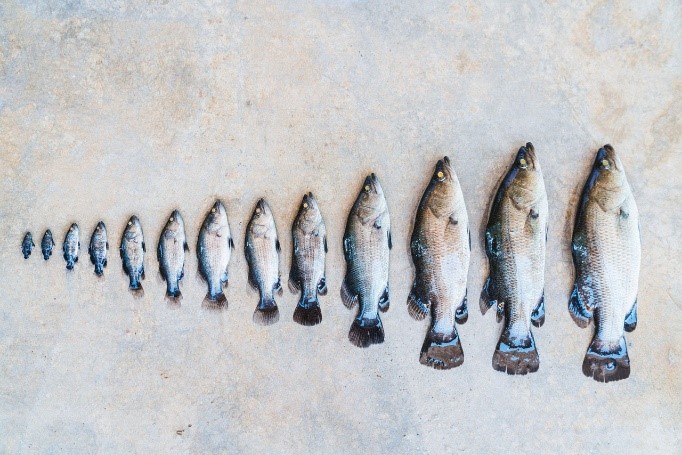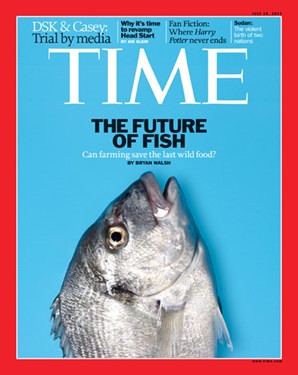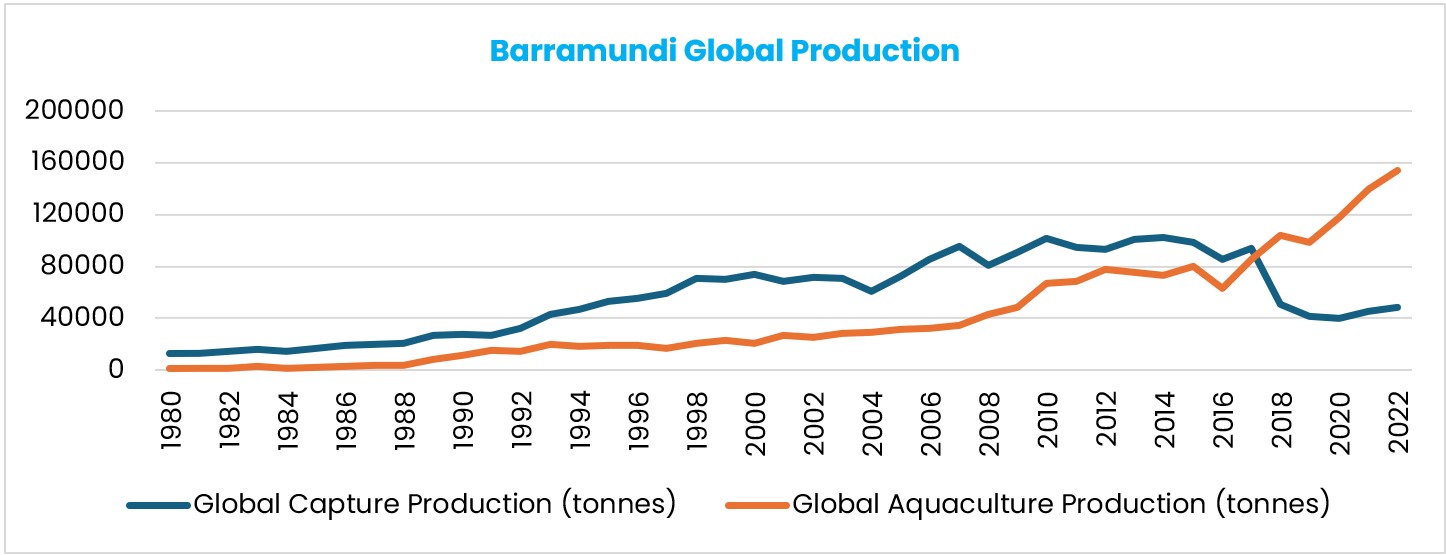Barramundi: is the ideal fish in a constantly changing world?
By Tancredi Fumagalli - Technical Sales Advisor
Barramundi (Lates calcarifer), also known as Asian or Australian sea bass, is an adaptable and resilient fish inhabiting coastal waters, rivers, and estuaries across Southeast Asia, Papua New Guinea, and northern Australia. Capable of thriving in a range of salinity levels and warm temperatures, Barramundi is well-suited for aquaculture. This species' ability to withstand fluctuating environmental conditions, including changes in temperature and salinity, highlights its resilience to climate change. Additionally, Barramundi's efficient feed conversion ratio and natural disease resistance make it a sustainable option for aquaculture, supporting global seafood demands and providing economic opportunities for coastal communities.
Introduction
The term barramundi, borrowed from the Australian Aboriginal language, means "large, scaly river fish." Also known as Asian or Australian sea bass, the barramundi inhabits coastal waters, rivers, estuaries, and lagoons in Southeast Asia, Papua New Guinea, and northern Australia. This adaptable fish can tolerate all levels of salinity, from freshwater to seawater, and is found in a variety of environments including coastal regions, landlocked freshwater billabongs, and rivers. It prefers warm waters with temperatures between 26 and 30°C, where it feeds on crustaceans, mollusks, and small fish.
Barramundi (Lates calcarifer) are sequential hermaphrodites: many individuals begin their lives as males and become females after one breeding season, typically when they reach around 5 kg in weight. Juvenile males start in the freshwater reaches of rivers, migrating to brackish environments to breed. Spawning occurs between November and February, on the third night of the full moon, coinciding with mid-evening high tides. Each female can lay up to 40 million eggs, which hatch within 18 hours, with the fry ready to feed two days later.
These fish grow quickly and can reach up to 1.8 meters in length and 60 kg in weight. Their carnivorous diet consists of live prey such as fish and prawns. The barramundi’s majestic appearance and size make it a premier sport and table fish, and a valuable recreational fishery thrives on this species in the tropical regions of Australia.
Life cycle
The Barramundi life cycle includes stages of eggs, larvae, juveniles, and adults, each with specific ecological needs. Reproduction occurs in brackish and marine waters, with females producing up to 2.5 million eggs per kg of body weight per spawning cycle. Eggs hatch within 15-20 hours at 26-30°C, and larvae, measuring about 1.5-2 mm at hatching, rely on zooplankton for survival. The transition to juveniles occurs in estuaries and mangroves, which provide protection and food until they reach 20-30 cm.
Fig.1: FAO Cultured aquatic species information programme, Production cycle of Lates calcarifer

Barramundi reach sexual maturity at 2-4 years, with males maturing earlier and often changing to females later in life. This protandrous hermaphroditism optimizes reproductive success, as larger females produce more eggs. Optimal growth conditions for Barramundi include water temperatures of 28-32°C and a salinity range of 0-35 ppt. Their diet primarily consists of fish and crustaceans in the wild, but in aquaculture, they are fed high-protein pellets. Relevant research (Glencross et al. 2006 and Williams et al. 2013) highlights the importance of balanced nutrition in promoting growth and disease resistance.
Common diseases in Barramundi aquaculture include viral nervous necrosis (VNN) and parasitic infestations such as Neobenedenia, infecting the skin and eyes of Barramundi. Effective management practices involve biosecurity measures, vaccination, and regular health monitoring, important studies (Chong et al. 2005 and Munday et al. 2002) provide insights into disease prevention and treatment strategies. Major challenges in Barramundi farming include disease management and optimizing diets to enhance growth and resilience. However, the species' hardiness and the increasing demand for high-quality fish offer significant opportunities for expanding Barramundi aquaculture.
The life cycle of Barramundi is complex and adaptable, making it an ideal species for aquaculture. Studies and data collected, including those from the FAO, emphasize the importance of understanding the biological and environmental needs of this species to ensure sustainability and commercial success.
Barramundi aquaculture
The barramundi aquaculture, began in Thailand during the 1970s and rapidly expanded to Australia and much of Southeast Asia (Zhu et al. 2006; Yue et al. 2009). Today, barramundi is mainly farmed across its natural geographical range and in addition, it is being introduced for aquaculture in various other regions, including the United States, Europe, Saudi Arabia, and more recently, Iran. Notably, Iran is the only country in the Arabian Gulf to have initiated seacage aquaculture of L. calcarifer (FAO 2016; Yue et al. 2023). Barramundi does not seem to be native to the Arabian Gulf, and there are no credible records of this species being found in the wild there. The closest region where barramundi has been naturally documented is the west coast of India.
Wild fisheries account for approximately 60 percent of Barramundi production, but aquaculture efforts are intensifying and experiencing substantial annual growth. The capture fishery is primarily dominated by Indonesia, with Australia and Malaysia also contributing significantly to the global supply. Barramundi are well-suited for aquaculture due to their hardiness and rapid growth rate; farmed Barramundi can reach market sizes of 0.7 to 0.9 kg in less than a year. Leading producers in aquaculture include Taiwan, Malaysia, and Thailand.
Fig.2: Barramundi is a fast growing fish with a feed conversion ratio (FCR) around 1.5 to 1.7

World production of Barramundi is now around 168,000 metric tons annually, with growth observed in both wild catch and aquaculture production. Global aquaculture of Barramundi has shown remarkable expansion, increasing from 21,000 metric tons in 2000 to 154,000 metric tons in 2022, representing an impressive 620 percent growth (Fig.4).
In Asia, most Barramundi are marketed at weights of 500-900 grams, though some larger fish, ranging from 1 to 3 kg, are also sold. In Australia, farmed Barramundi is marketed primarily in two forms: "plate size" and fillet products. "Plate size" fish typically weigh between 350 and 500 grams, with larger "banquet" fish reaching up to 800 grams. Fillet product fish generally weigh between 2 to 3 kg.
Between sustainability and climate change
In Bryan Walsh's famous editorial “The future of fish” published in Time magazine on 7 July 2011, Josh Goldman CEO of Australis Aquaculture, who started his career breeding tilapia in the 1980s, described the barramundi as “The perfect fish”. This sentence was justified with the unique characteristics of the fish, that “It can survive in a wide variety of environments and lays eggs frequently. It has a flexible diet, and much like its fellow Australians, it is laid-back by nature, so it can endure the rigors of farming”. Australis is the world’s largest barramundi producer and aims to increase production to 50,000 tonnes a year - up from its current level of just under 10,000 tonnes In the meanwhile, the Australian Barramundi Farmers Association has developed and adopted a Code of Practice for Post-Harvest Handling of Farmed Barramundi; this is aimed at improving product quality through best post-harvest practices.
Fig. 3: TIME front cover The Future of Fish, 7.jul.2011

Barramundi Group, a leading aquaculture company based in Singapore, present in its website how they are committed to sustainability and certified with 4-star Best Aquaculture Practices (BAP). The Four-star certification indicates that the entire system, from feed mill to hatchery, the farm to processing plant, comply with BAP's standards. Barramundi Group currently produces around 2,000 tonnes of barramundi (Lates calcarifer) per year, and is aiming for 7,000 tonnes by 2026, with the ambition to expand its production of barramundi to approximately 30,000 tonnes per year in Australia and Brunei after the 2026.
For some years now, Saudia Arabia, with NAQUA (the National Aquaculture Group), has been breeding Barramundi in the Red Sea (as a non-native species it was introduced into the Red Sea for open sea-cage farming in 2008, with large-scale production beginning in 2014). The Red Sea is a particularly sensitive water basin in which mass tourism and responsible aquaculture, able to withstand the current strong changes dictated by the physical conformation and climate change, will have to coexist more and more. Naqua is currently producing 15,000 metric tons of fish, mostly barramundi, with the idea of increasing production several times by 2030.
The Barramundi serves as a prime example of how aquaculture can address global food demands while remaining sustainable amidst climate challenges. Barramundi's resilience to climate change is notable. It can tolerate a broad range of temperatures and salinities, which is crucial as ocean conditions fluctuate. Specifically, Barramundi can thrive in seawater temperatures up to 35°C, well above the current average temperatures of 27°C to 31°C in its native habitats. This tolerance makes Barramundi particularly suitable for aquaculture in the face of rising global temperatures (The Fish Site). Furthermore, Barramundi can adapt to varying salinities, from freshwater to seawater (0ppt to over 40ppt), enhancing its suitability for diverse aquaculture environments. Its feed conversion ratio (FCR) ranges from 1.5 to 1.7, which is more efficient than many other farmed species such as beef, pork, and chicken. This efficiency translates to lower resource use and reduces environmental impact, contributing to more sustainable aquaculture practices. Barramundi holds significant potential for supporting global seafood demands and providing economic opportunities.
The FAO projects that the global demand for edible marine finfish will reach 200 million tonnes by 2050. Given its adaptability to varying environmental conditions and its efficient growth, Barramundi is well-positioned to be a pivotal species in meeting this demand in a sustainable way.
Fig. 4: Global production of Barramundi (L. calcarifer) 1980-2022, data from FAO Fisheries and Aquaculture database
